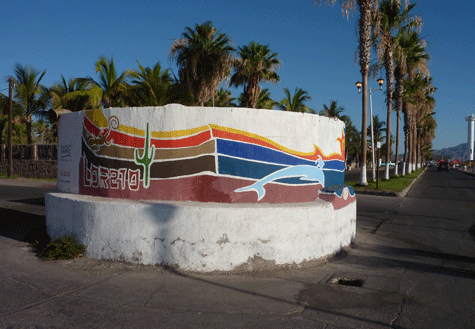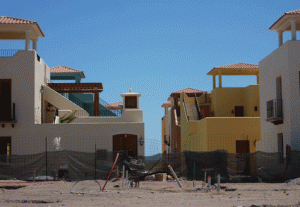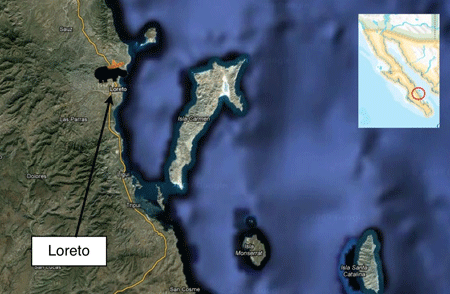Location: Hotel San Carlos in Loreto, southern Baja, two blocks from the waterfront.
Conditions: Outside, the sun is shining, but I’m lying in my room feeling nauseous, suffering through my first stomach bug this trip.
Discussion: Imagine saying, “Honey, the water truck is coming!” Then your husband puts down the breakfast cereal and bolts out the door to catch the truck, waving money to indicate he is worth the driver’s time. Pamela Bolles, a Loreto resident for 11 years, explained: “The truck used to come three times a week, now it’s every 10 days, if we’re lucky. We need to be on our toes to get water.”
Pamela lives in Colonia, a neighborhood located in the outskirts of Loreto, a growing tourist town with 13,000 residents and 60,000 annual visitors. Colonia is not connected to the water main, which feeds the town of Loreto and nearby development at Nopolo. Pamela runs a sportfishing business with her husband and is on the board of a local nonprofit called Eco-Allianza, which advocates for the preservation of water resources in the area.

Since she might have experience in these things, I asked Pamela about my stomach bug. Alyssum thought the only possible culprit was the sink water I brushed my teeth with (instead of using our purified water) since we have been eating identically. I asked Pamela if that seemed like a long shot. “Not really. When I return from a long trip to the States, I often get sick for a day or two. The city water is supposedly treated, but I wouldn’t count on it.”
Although I can’t see how they are related, the stench of sewage on the street didn’t enhance my confidence in the local water quality. It emanated from open-air structures in the waterfront (the town’s lowest point) that pump the sewage to a treatment plant. Nice murals with ecological messages are painted on the pumping structures, which is a lovely irony when you are holding your breath to keep from passing out while driving by. Otherwise, the waterfront is well done, with cute marine animals posing as trash cans.

Like other remote outposts in this corner of Baja, Loreto had its beginnings as a luxury fly-in destination for wealthy sports fishermen and socialites in the ’50s and ’60s. When the Transpeninsular Highway was completed in 1973, the area was targeted as a planned resort by FONATUR, the federal government’s tourism development agency.
Cancún was FONATUR’s first baby, previously an isolated island with a handful of fishermen, until it was conceived as a master development to bring tourist dollars into Mexico. According to Joel Simon’s book Endangered Mexico (see a review here), the architects of Cancún had every intention to avoid the pollution issues plaguing the uncontrolled boom of Acalpuco and established building codes and sound infrastructure to safeguard the quality of the new city. However, after the collapse of oil prices in the early ’80s, Mexico was no longer able to pay the big debts it had incurred on the confidence of its oil supply and had to put the afterburners on the one industry that was bringing in dollars: tourism.
Building codes were relaxed and growth went unchecked, instigating the sewage outfalls and immigrant flood that Cancún suffers today. Nevertheless, it was considered an economic success, so the model of Cancún was applied to other destinations: Los Cabos, Ixtapa and Huatulco. The formula is always the same: build three or four hotels, an international airport with good roads, carve out a marina, sprinkle on two golf courses, pump in lots of water, and poof! Wealthy gringos would come, with investors in tow to expand the resort.
The FONATUR development in Loreto, located just north of town on the beach of Nopolo, was designed using the same formula. This time, however, instead of high-rise hotels, they decided to build thousands of beach houses to capitalize on the demand for second homes from baby boomer Americans and Canadians. The scales are gigantic: about 6,000 to 12,000 homes and rooms are on the drawing board, depending on where you are looking. The master architects know they will need a lot of water, so FONATUR built a 27-kilometer (16-mile) distribution system to collect water from the aquifer in the mountains.
Outside of the river oasis that cuts through Loreto, the landscape is a parchment-dry desert, which makes the green golf courses and thousands of colorful homes being built in Nopolo really … stand out. Like an enchanted wonderland or an array of sore thumbs, I can’t tell.

Known as the Villages of Loreto Bay, the development has no shortage of good principles. The parent company’s grandiose name is a good start, the Trust for Sustainable Development (although the managing company has now gone bankrupt). Its website describes a veritable buffet of eco-design features for its residents, such as walkable communities, New Urbanism, green preserves, renewable energy and low-water use. An online journal called Terrain.org had quite a positive outlook on the development’s sustainability in its Unsprawl section.
Although I applaud these efforts, I wonder: Is this just blatant greenwashing? Is there enough water for all this? Thanks to FONATUR’s aquifer project, people seem to think so. In the town of Loreto, residents casually water the dirt roads with hoses so that the dust doesn’t rise with the wind. While I was driving past highway exits — which are manicured with an idiosyncratic mixture of grassy lawns, cacti and palm trees — I noticed maintenance workers watering the grass with their water trucks. It was noon, almost the hottest time of the day.
I visited the local water agency, Oomsapa, which told me that only four out of the 10 wells are being used in the aquifer — so there is “plenty of water for a population of 60,000.” Of course, the number of wells is not as important as the rate of withdrawal, which would indicate if the aquifer is being depleted faster than being recharged by rain; but I was not afforded that valuable information.
One saving grace is that the golf course is supposedly irrigated with the greywater from the town. Regarding droughts or climate change, the representative I spoke to was unconcerned: “There is plenty of water,” he echoed.
The folks at Eco-Allianza, which now participate in the Waterkeeper Alliance, had another perspective. Pamela explained: “They are calculating water demand based on the new units. However, studies from Cancún and Los Cabos show that 10 to 15 additional people migrate to the area per unit [e.g. home or hotel room]. You do the math — that’s a lot more pressure on water and sewage than is accounted for.”

Labor force is imported from elsewhere in the country for mega-developments; when construction workers see the opportunities in the area, many move in and invite their family members. The study “Alternative Futures for the Region of Loreto” estimates a total population in the region in the year 2025 of between 90,000 and 240,000 inhabitants, if tourist units reach a total of between 6,000 and 12,000.
What if the water ran out, due to drought or unforeseen growth, what would they do? There has already been talk of desalination plants in the area, which are the controversial (and expensive) solution many desert communities rely on.
“Technically, they are not allowed to,” I was told by Israel Popoca, who overseas the Loreto Bay National Marine Park for Mexico’s national park service. “Our management plan doesn’t allow discharges of any kind into the bay.” Desalination removes the salt from sea water and then typically discharges a brine solution back into the ocean (or into aquifers). “The salinity would probably affect our commercially fished clams or the fish habitat.” But realistically, when push comes to shove in the next 20 years, I wonder whether the park’s management plan will hold up.
As I drove out of town, I paused on the hill to look at Nopolo. Is a master-planned development better than organic growth? Is it all that different? Like Dr. Jekyll and Mr. Hyde, either can flip from being a beauty to a monstrosity without much notice. Maybe it’s a question of scale. Does “too big, too fast” equal “too much” — no matter how it’s done?
My optimism unsettled by a slowly fading nausea, I got in El Hippo and drove south to La Paz, my last stop on the Baja peninsula.





